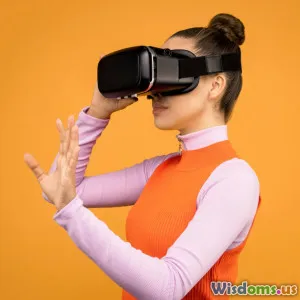
Understanding the Impact of VR vs. AR in Medical Education
10 min read Explore how VR and AR reshape medical education by immersive training, with unique benefits and challenges. (0 Reviews)
Understanding the Impact of VR vs. AR in Medical Education
Medical education has consistently evolved, from the era of textbooks to the integration of cutting-edge technology. Among the most transformative advances are Virtual Reality (VR) and Augmented Reality (AR) — two immersive technologies revolutionizing how students and professionals learn anatomy, surgical procedures, and patient care. But how do these two differ in their impact? And what distinct benefits do they offer in medical training? This article dives deep into VR vs. AR in medical education, exploring their current applications, advantages, and future implications.
Introduction: Why Immersive Technologies Matter in Medical Education
Imagine a medical student performing a complex surgery without risking patient safety or a radiologist visualizing scanners in real-time placement on actual patients. This is no longer the realm of science fiction but reality driven by VR and AR.
Traditional medical training often relies heavily on cadavers, textbooks, and at times, limited clinical exposure. While effective, these methods have limitations in scope, accessibility, and learner engagement. Immersive technologies enhance experiential learning by enabling students to practice repeatedly, visualize anatomy live, and receive immediate feedback — features difficult to achieve through conventional methods.
What Are VR and AR? Defining the Technologies
Before exploring impacts, understanding the core difference is essential:
-
Virtual Reality (VR): Provides a fully immersive digital environment where users can interact with 3D models and simulations isolated from the real world. For example, learners can enter a virtual operating room to practice incisions without physical risk.
-
Augmented Reality (AR): Overlays digital information or 3D objects onto the real-world environment, enhancing natural surroundings with meaningful data. An example is a medical student viewing rendered layers of the heart superimposed on a physical mannequin.
Both technologies engage spatial cognition but differ fundamentally in immersion and user interaction.
VR in Medical Education: Immersion for Hands-On Mastery
Applications and Examples
VR's immersive nature is highly effective for surgical training. Platforms like Osso VR offer realistic haptic feedback and surgical scenarios for orthopedic and general surgery residents. Studies report that VR training improved surgical precision and reduced errors by up to 38% compared to traditional methods (Aggarwal et al., 2017).
Other applications include:
- Anatomy Visualization: Virtual Cadaver Labs such as The Body VR allow students to explore organs and systems at microscopic levels, aiding retention.
- Emergency Response Simulations: VR scenarios train professionals in high-stress environments, improving decision-making under pressure.
Benefits
- Safe Repeated Practice: Trainees can master procedures risk-free.
- Standardized Learning: Consistent simulations reduce variability across teaching sites.
- Engagement: Interactive VR leads to better knowledge absorption.
Challenges
- Cost and Accessibility: High-fidelity VR rigs remain expensive.
- Simulator Sickness: Some users experience disorientation or nausea.
- Lack of Real-World Context: Isolated virtual environments may limit contextual learning.
AR in Medical Education: Enhancing Reality with Interactive Layers
Applications and Examples
AR integrates digital elements with real patient care environments, bridging theory and practice.
- Surgical Navigation: Tools like Microsoft HoloLens assist surgeons with 3D overlays during procedures, displaying patient imaging data without looking away.
- Anatomy Learning Adjusted to Physical Models: Apps such as AnatomyX superimpose detailed anatomy over mannequins or real bodies.
- Remote Assistance: AR enables expert clinicians to guide trainees remotely, pointing out critical anatomy or procedural steps.
Benefits
- Contextual Learning: Trainees learn in real environments, improving transfer of skills.
- Real-Time Feedback: Immediate data overlay supports faster correction.
- Collaboration: Multi-user AR sessions promote teamwork.
Challenges
- Technical Limitations: Tracking accuracy and latency issues can hinder effectiveness.
- Integration with Existing Workflows: AR must align seamlessly with varied clinical settings.
- Cost of Development: Customized AR applications require significant investments.
Comparing Impact: Which Technology Holds More Promise?
| Aspect | Virtual Reality (VR) | Augmented Reality (AR) |
|---|---|---|
| Immersion | Fully immersive simulating full scenarios | Partial, blends digital with real-world |
| Safety | Risk-free simulated environments | Applied to real settings; some risks remain |
| Accessibility | Costly equipment, dedicated environments | More mobile; devices like tablets, headsets |
| Training scope | Best for isolated, skill-based practice | Best for contextual, procedural support |
| Realism | Visual and haptic feedback possible | Integrates real-world visuals for realism |
Experts suggest a complimentary role. Dr. Sarah Lee, a surgical educator, notes, “VR is excellent for mastering foundational skills, while AR excels as an assistive tool during actual procedures.”
Real-World Insights and Data
A 2021 survey by The Lancet reported that over 60% of medical schools worldwide have begun integrating VR and AR tools in some form. Moreover, a study published in JMIR Medical Education found a 25% increase in student engagement and test scores following AR-assisted anatomy courses.
Hospitals employing AR-assisted surgeries noted a 15% reduction in operation time and a notable improvement in targeting precision, critical factors in minimizing patient trauma.
Future Outlook: Towards Hybrid and AI-Enhanced Training
Forthcoming trends hint at blending VR and AR benefits, termed Mixed Reality (MR), combining immersion and real-world context. AI is also poised to personalize simulations — adapting difficulty based on learner performance.
Companies like FundamentalVR are pioneering AI-driven VR platforms that adapt surgical scenarios. Furthermore, cloud-based collaboration tools could allow global student cohorts to learn from VR/AR environments synchronously.
Challenges such as cost reduction, improved hardware ergonomics, and robust evidence of educational efficacy remain crucial for expansive adoption.
Conclusion: Leveraging VR and AR for a Medical Education Revolution
Both Virtual Reality and Augmented Reality offer transformative potential in medical education, enhancing traditional training with innovative, immersive techniques. VR's fully immersive scenarios enable safe and focused skill mastery, while AR empowers real-world contextual understanding and live procedural aid.
Medical educators and institutions should consider strategies that harness the strengths of both technologies to create comprehensive learning experiences. As technology matures and becomes more accessible, the gap between theoretical knowledge and practical expertise in healthcare will significantly narrow, ultimately improving patient outcomes.
Embracing this technology-driven future not only prepares the healthcare workforce better but also elevates the standards of medical training worldwide.
References
- Aggarwal, R., et al. (2017). Virtual reality simulation training can improve surgical performance: A systematic review and meta-analysis. Surgical Endoscopy, 31(8), 3149–3160.
- The Lancet (2021). Survey on medical education's technological adoption.
- JMIR Medical Education (2020). Efficacy of AR-assisted cognitive learning.
- FundamentalVR: https://www.fundamentalvr.com/
- Microsoft HoloLens for Medical: https://www.microsoft.com/en-us/hololens/
Rate the Post
User Reviews
Popular Posts



















